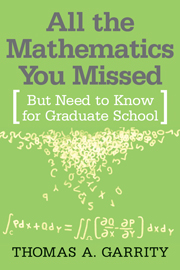Book contents
- Frontmatter
- Contents
- Preface
- On the Structure of Mathematics
- Brief Summaries of Topics
- 1 Linear Algebra
- 2 ∈ and δ Real Analysis
- 3 Calculus for Vector-Valued Functions
- 4 Point Set Topology
- 5 Classical Stokes' Theorems
- 6 Differential Forms and Stokes' Thm.
- 7 Curvature for Curves and Surfaces
- 8 Geometry
- 9 Complex Analysis
- 10 Countability and the Axiom of Choice
- 11 Algebra
- 12 Lebesgue Integration
- 13 Fourier Analysis
- 14 Differential Equations
- 15 Combinatorics and Probability
- 16 Algorithms
- A Equivalence Relations
- Bibliography
- Index
6 - Differential Forms and Stokes' Thm.
Published online by Cambridge University Press: 11 April 2011
- Frontmatter
- Contents
- Preface
- On the Structure of Mathematics
- Brief Summaries of Topics
- 1 Linear Algebra
- 2 ∈ and δ Real Analysis
- 3 Calculus for Vector-Valued Functions
- 4 Point Set Topology
- 5 Classical Stokes' Theorems
- 6 Differential Forms and Stokes' Thm.
- 7 Curvature for Curves and Surfaces
- 8 Geometry
- 9 Complex Analysis
- 10 Countability and the Axiom of Choice
- 11 Algebra
- 12 Lebesgue Integration
- 13 Fourier Analysis
- 14 Differential Equations
- 15 Combinatorics and Probability
- 16 Algorithms
- A Equivalence Relations
- Bibliography
- Index
Summary
Basic Objects: Differential Forms and Manifolds
Basic Goal: Stokes' Theorem
In the last chapter we saw various theorems, all of which related the values of a function on the boundary of a geometric object with the values of the function's derivative on the interior. The goal of this chapter is to show that there is a single theorem (Stokes' Theorem) underlying all of these results. Unfortunately, a lot of machinery is needed before we can even state this grand underlying theorem. Since we are talking about integrals and derivatives, we have to develop the techniques that will allow us to integrate on k-dimensional spaces. This will lead to differential forms, which are the objects on manifolds that can be integrated. The exterior derivative is the technique for differentiating these forms. Since integration is involved, we will have to talk about calculating volumes. This is done in section one. Section two defines differential forms. Section three links differential forms with the vector fields, gradients, curls and divergences from last chapter. Section four gives the definition of a manifold (actually, three different methods for defining manifolds are given). Section five concentrates on what it means for a manifold to be orient able. In section six, we define how to integrate a differential form along a manifold, allowing us finally in section seven to state and to sketch a proof of Stokes' Theorem.
- Type
- Chapter
- Information
- All the Mathematics You MissedBut Need to Know for Graduate School, pp. 111 - 144Publisher: Cambridge University PressPrint publication year: 2001



